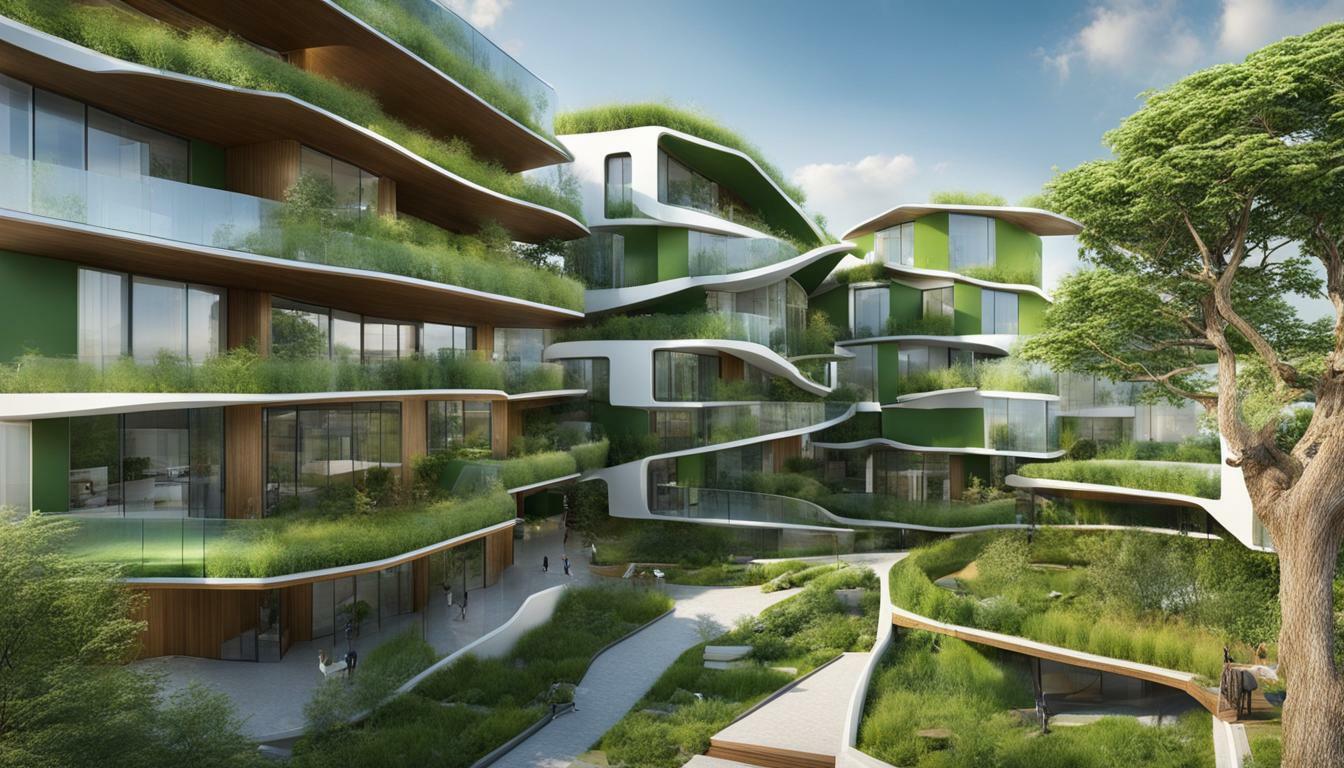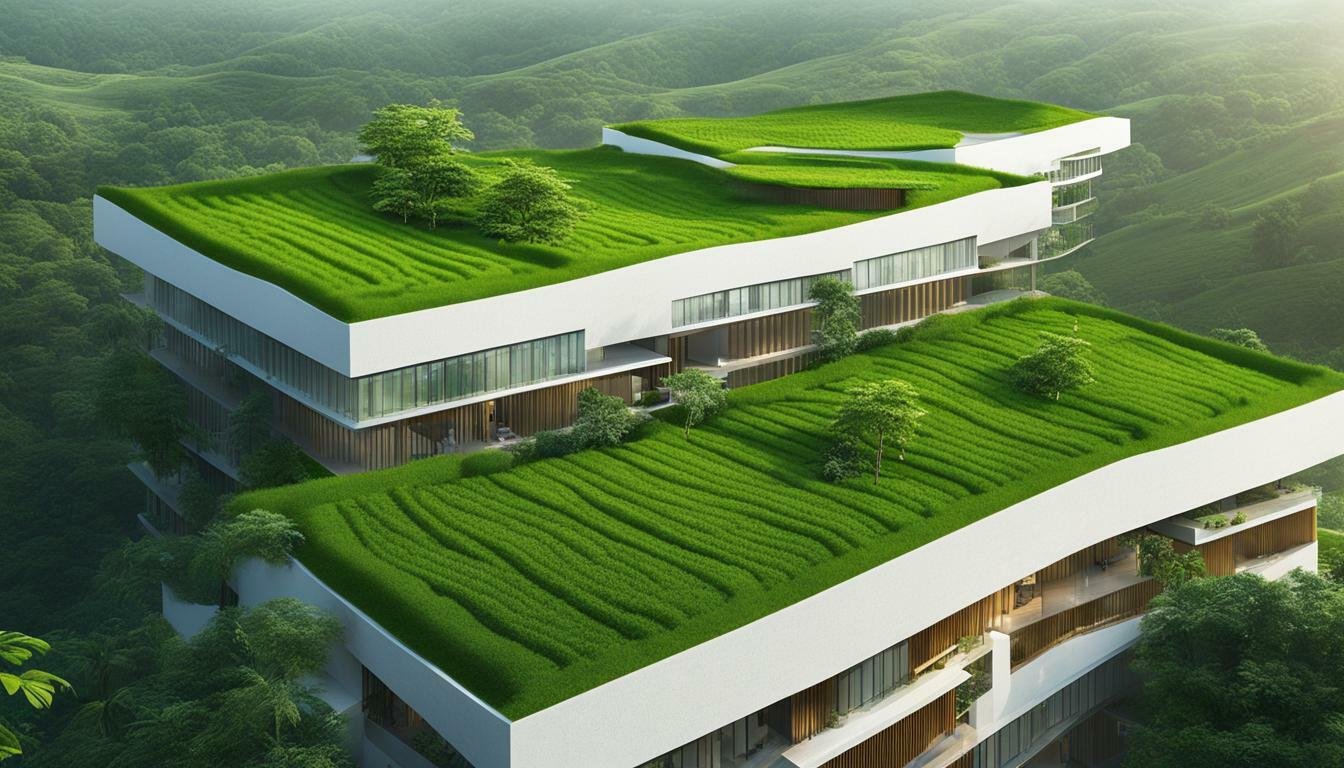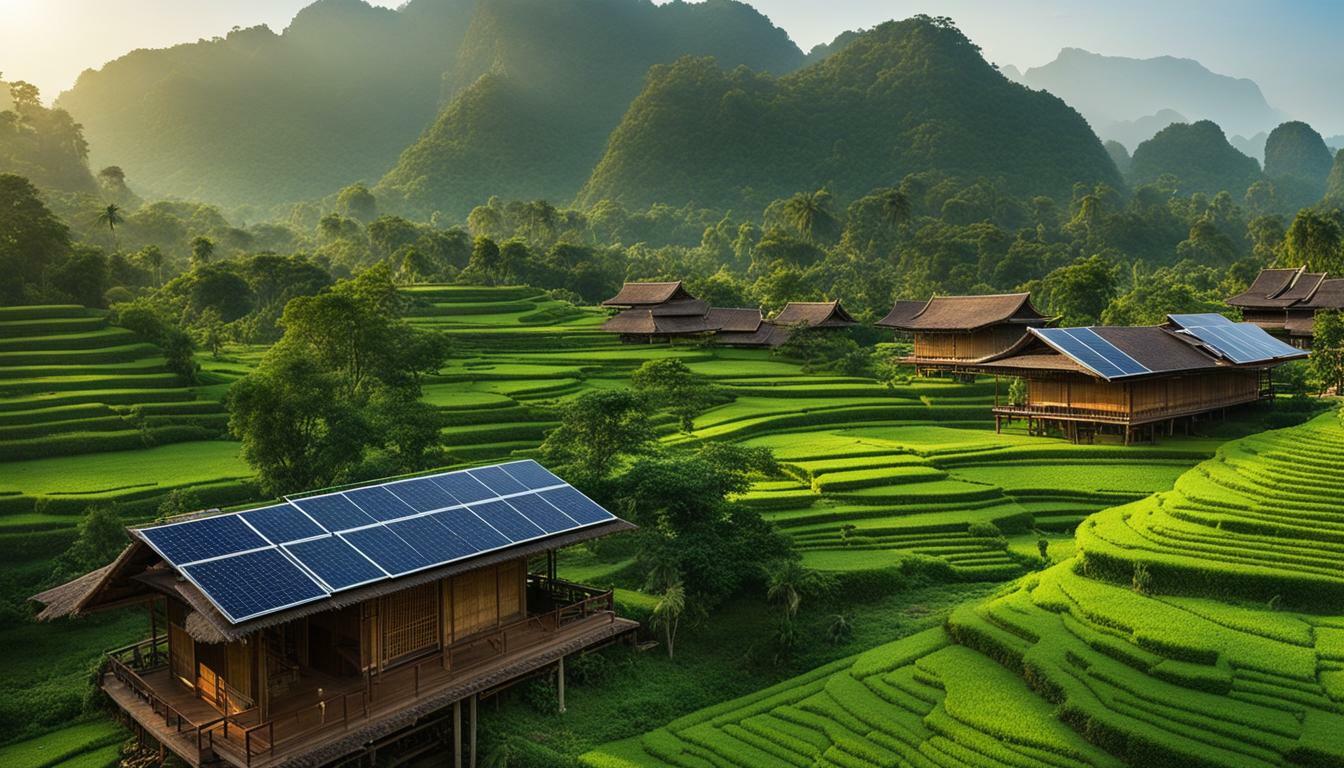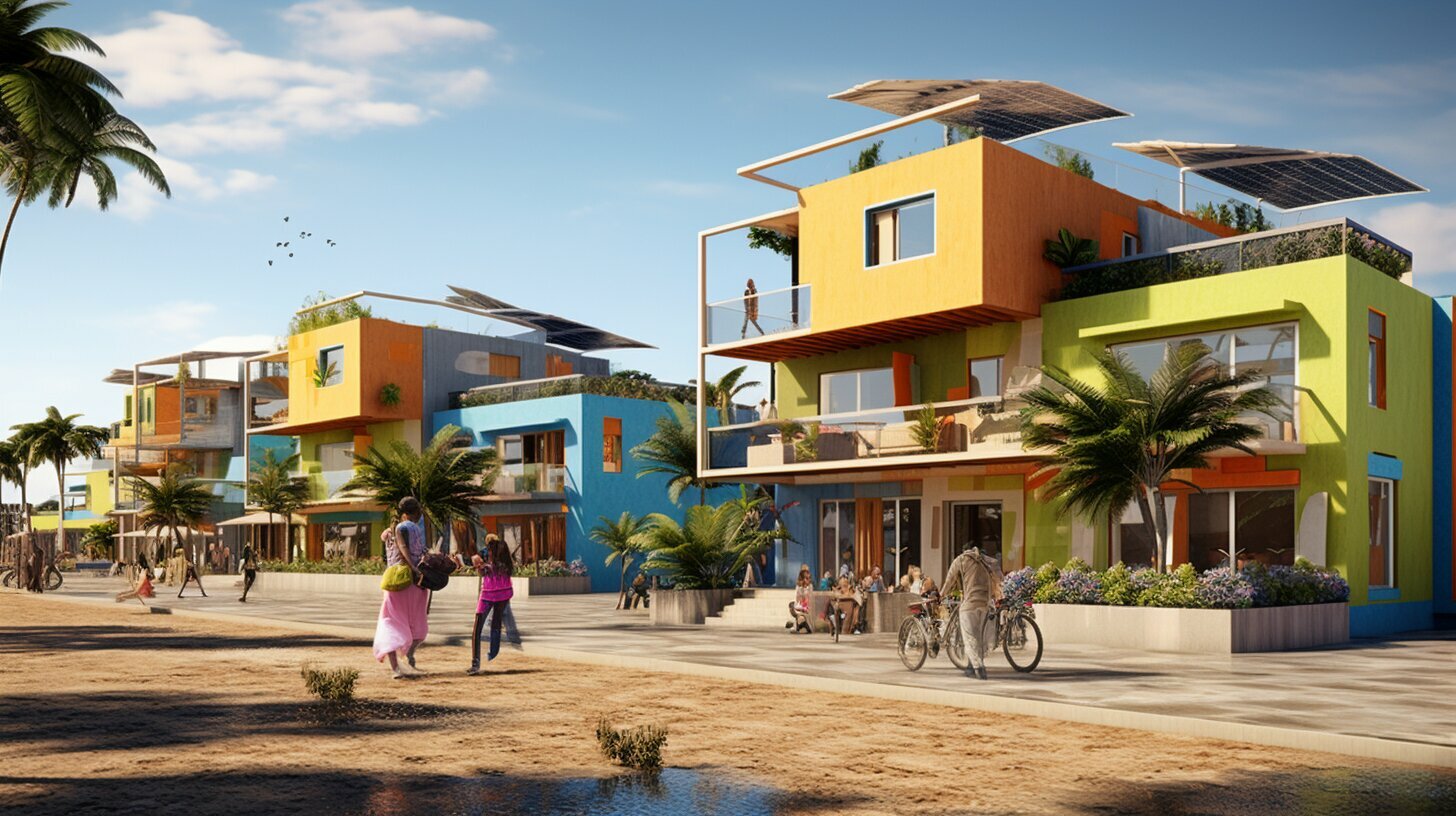Egypt Top Green Buildings
Egypt is witnessing a growing number of top green buildings that combine modern architecture with sustainable practices, addressing the pressing water and energy challenges the country faces. One example of such a building is the “Green Farm Village” constructed for Royal Herbs, an organic tea producer. Designed by ECOnsult, this eco-friendly architecture marvel incorporates sustainable practices such as passive design, locally-sourced materials, and energy-efficient techniques. The village consists of three buildings, including workers’ housing, a guest house, and an engineers’ residence, all of which collectively save up to 63% on energy and 53% on water consumption. This project not only focuses on creating environmentally-friendly buildings but also emphasizes community-building and staff training to implement green building practices.
Key Takeaways:
- Egypt is embracing the concept of eco-friendly architecture and sustainable construction practices.
- The “Green Farm Village” for Royal Herbs is a prime example of a top green building in Egypt.
- The project incorporates passive design, locally-sourced materials, and energy-saving techniques.
- The eco-village saves up to 63% on energy and 53% on water consumption.
- Community-building and staff training are important aspects of green building projects in Egypt.
The “Green Farm Village” for Royal Herbs
One notable example of a top green building in Egypt is the “Green Farm Village” designed by ECOnsult for Royal Herbs, a renowned organic tea producer. This eco-friendly architecture project showcases sustainable practices and sets an example for others in the industry.
The “Green Farm Village” is a collection of three distinct buildings, each serving a specific purpose. The workers’ housing, guest house, and engineers’ residence are all designed with passive design principles, utilizing locally-sourced materials and implementing energy-saving techniques. This approach not only reduces the project’s carbon footprint but also ensures the efficient use of resources.
The eco-village is designed to be energy and water-efficient, saving up to 63% on energy consumption and 53% on water usage. By incorporating sustainable practices, the project contributes to Egypt’s efforts in addressing the country’s water and energy challenges. Additionally, the project focuses on community-building by involving the local residents and training staff members in implementing and maintaining sustainable practices.
Green Farm Village Overview:
| Building Type | Key Features |
|---|---|
| Workers’ Housing | Passive design, locally-sourced materials, energy-saving techniques |
| Guest House | Passive design, locally-sourced materials, energy-saving techniques |
| Engineers’ Residence | Passive design, locally-sourced materials, energy-saving techniques |
The “Green Farm Village” for Royal Herbs is an outstanding example of how eco-friendly architecture and sustainable practices can be integrated into building design. It not only showcases the environmental benefits of such buildings but also highlights the importance of community engagement and staff training in maintaining these sustainable practices for the long term.

AUC’s Faculty Housing Building
AUC’s Faculty Housing Building is leading the way in green architecture in Egypt, with its pursuit of LEED certification and innovative sustainable features. This remarkable building incorporates various eco-friendly elements that contribute to energy efficiency, water conservation, and overall sustainability.
One notable feature of the AUC’s Faculty Housing Building is its green roof, which not only enhances the aesthetic appeal of the structure but also improves insulation, reduces stormwater runoff, and mitigates the urban heat island effect. This environmentally friendly design helps to regulate indoor temperature, reduce energy consumption for cooling, and promote biodiversity in urban areas.
The building further promotes sustainability through the use of solar water heaters, harnessing the power of the sun to provide hot water for the residents. This renewable energy source significantly reduces the building’s reliance on conventional heating methods, resulting in lower energy consumption and carbon emissions.

In addition, the AUC’s Faculty Housing Building incorporates environmentally friendly cooling refrigerants, which not only ensure efficient cooling but also minimize the building’s impact on ozone depletion and global warming. This strategic choice aligns with the building’s commitment to sustainable practices and showcases the importance of responsible technology usage in reducing environmental harm.
Another unique feature of this green building is its rooftop farming initiative, which utilizes the available space on the roof to cultivate plants and grow fresh produce. This innovative approach not only supports local food production and reduces the carbon footprint associated with transportation but also enhances the building’s overall sustainability by creating a green and lush environment.
Sustainable Features of AUC’s Faculty Housing Building:
| Feature | Description |
|---|---|
| Green Roof | Enhances insulation, reduces stormwater runoff, and mitigates the urban heat island effect. |
| Solar Water Heaters | Utilizes solar energy to provide hot water, reducing energy consumption and carbon emissions. |
| Environmentally Friendly Cooling Refrigerants | Efficient cooling while minimizing environmental impact on ozone depletion and global warming. |
| Rooftop Farming | Utilizes roof space for cultivating plants, promoting local food production and reducing transportation carbon footprint. |
Challenges and Efforts in Green Building Adoption
While Egypt’s top green buildings showcase impressive sustainable practices, they also encounter challenges in terms of education and affordability. To further promote the adoption of green building practices, it is essential to address these obstacles and make sustainable technologies more accessible for all.
One of the main challenges faced by green buildings in Egypt is the lack of awareness and education among the general population. Many people are not familiar with the benefits of eco-friendly architecture and sustainable construction, which can hinder the demand for green buildings. Efforts should be made to educate the public about the advantages of green living and the positive impact it can have on the environment and their quality of life.
Affordability is another significant challenge for green building adoption. While sustainable technologies and materials may initially have a higher upfront cost, they often provide long-term savings in terms of energy efficiency and maintenance. However, the initial cost can be a barrier for many individuals and organizations, especially in developing countries like Egypt. To overcome this challenge, it is crucial to implement policies and incentives that promote the affordability of green building materials and technology.
In recent years, there have been significant efforts to address these challenges and promote the adoption of green building practices in Egypt. Organizations and government initiatives are working towards providing financial support, subsidies, and incentives for sustainable construction projects. Additionally, there is a growing emphasis on research and development of affordable and locally-sourced green building materials. These efforts aim to make green building practices accessible to a wider range of individuals and organizations, ultimately contributing to a more sustainable built environment in Egypt.
| Challenges | Efforts |
|---|---|
| Lack of awareness and education | Educate the public about the benefits of green living and sustainable construction |
| Affordability | Implement policies and incentives to promote the affordability of green building materials and technology |
“While Egypt’s top green buildings showcase impressive sustainable practices, they also encounter challenges in terms of education and affordability.”

A crucial aspect of successful green building projects in Egypt is community engagement and training staff members to embrace and implement sustainable practices. By involving the community in the planning and development process, green building projects can create a sense of ownership and promote a culture of environmental awareness. This can be achieved through open forums, workshops, and educational campaigns that educate community members about the benefits of sustainable construction and green living.
Training staff members is equally important, as they play a key role in the day-to-day operations of green buildings. By providing comprehensive training on sustainable practices, such as energy-efficient operations and waste management, staff members can contribute to the long-term success and maintenance of green building initiatives. This ensures that sustainable practices are consistently implemented and upheld, maximizing the environmental benefits of green buildings.
Furthermore, community engagement and staff training in green building projects can foster a sense of pride and unity, as individuals come together to work towards a common goal of sustainable development. This collaborative approach not only strengthens the bond within the community but also creates a platform for knowledge sharing and continuous improvement in sustainable practices.
Example of Community Engagement and Training
An exemplary case of community engagement and staff training in green building projects is the “Green Farm Village” for Royal Herbs. In addition to its sustainable design features, the project actively involves the local community in various initiatives. The village serves as a training hub for organic farming and sustainable agriculture practices, empowering community members with valuable skills and knowledge. Workshops are conducted regularly to educate residents on waste management, water conservation, and green energy solutions. This holistic approach ensures that the entire community is actively engaged in promoting and maintaining sustainable practices within the village.

| Benefits of Community Engagement and Staff Training in Green Building Projects: |
|---|
| 1. Increased awareness and understanding of sustainable practices. |
| 2. Enhanced community ownership and pride in green building initiatives. |
| 3. Improved long-term maintenance of green buildings. |
| 4. Knowledge sharing and continuous improvement in sustainable practices. |
Green Building Impact on Energy and Water Conservation
Green buildings in Egypt play a vital role in energy and water conservation, thanks to their sustainable practices and eco-friendly designs. These buildings incorporate a range of innovative technologies and strategies that contribute to significant reductions in energy consumption and water usage. By adopting environmentally conscious construction methods and utilizing energy-efficient systems, green buildings are helping to address Egypt’s water and energy challenges.
One example of the positive impact of sustainable practices can be seen in the “Green Farm Village” constructed for Royal Herbs, an organic tea producer. Designed by ECOnsult, this eco-village integrates passive design techniques, such as natural ventilation and shading, to reduce the need for artificial cooling. Locally sourced materials are used throughout the construction, minimizing the carbon footprint associated with transportation. Furthermore, energy-saving techniques, such as solar panels, are employed to generate clean electricity for the village’s buildings. These measures result in impressive energy savings of up to 63% and water savings of up to 53%.

Another noteworthy green building in Egypt is AUC’s faculty housing building, which is pursuing LEED certification. The building incorporates various sustainable features, including a green roof that provides insulation and reduces stormwater runoff. Solar water heaters are installed to harness the sun’s energy for water heating purposes, reducing the reliance on conventional energy sources. Environmentally friendly cooling refrigerants are used to minimize the building’s ecological impact. Additionally, the rooftop is utilized for farming, contributing to local food production and enhancing the building’s sustainability credentials. LED lighting fixtures are installed throughout the building, promoting energy efficiency and reducing electricity consumption.
Green buildings face challenges in Egypt, particularly in terms of education and affordability. Many individuals are not aware of the benefits and importance of sustainable construction practices. Additionally, the cost of implementing green technologies can be prohibitive for some developers and homeowners. However, efforts are being made to address these challenges and promote the adoption of green building practices. Education and awareness programs are being conducted to highlight the advantages of sustainable living, and financial incentives are being offered to encourage the incorporation of eco-friendly features in buildings. By overcoming these obstacles, Egypt can further advance its commitment to creating a greener and more sustainable built environment.
| Key Benefits of Green Buildings in Egypt |
|---|
| Significant reduction in energy consumption |
| Substantial decrease in water usage |
| Promotion of sustainable construction practices |
| Enhancement of indoor environmental quality |
| Contribution to a more resilient and eco-friendly built environment |
Conclusion
Egypt’s top green buildings are paving the way for eco-friendly architecture, sustainable construction, and the integration of green building practices in the country. With its water and energy challenges, Egypt recognizes the importance of adopting environmentally-friendly buildings that prioritize energy-efficient designs and sustainable practices.
One exemplary green building is the “Green Farm Village” designed for Royal Herbs, an organic tea producer. Constructed by ECOnsult, this eco-village showcases the benefits of passive design, locally-sourced materials, and energy-saving techniques. The village consists of workers’ housing, a guest house, and an engineers’ residence, collectively achieving impressive savings of up to 63% on energy and 53% on water. Additionally, the project emphasizes community-building and staff training to ensure the implementation of sustainable practices.
AUC’s faculty housing building is another notable green building in Egypt, currently pursuing LEED certification. This sustainable structure incorporates a range of features, including a green roof, solar water heaters, environmentally friendly cooling refrigerants, rooftop farming, and LED lighting. By prioritizing these green building elements, AUC’s faculty housing building sets an example for other construction projects in the country.
While green buildings in Egypt face challenges related to education and affordability, efforts are being made to promote environmental awareness and make sustainable technologies more accessible. Egypt’s top green buildings not only contribute to energy and water conservation but also foster a sense of community engagement and empower individuals to embrace sustainable practices.
FAQ
What are some examples of top green buildings in Egypt?
Two notable examples of top green buildings in Egypt are the “Green Farm Village” for Royal Herbs and AUC’s Faculty Housing Building.
What sustainable practices are incorporated into the Green Farm Village?
The Green Farm Village incorporates sustainable practices such as passive design, the use of locally-sourced materials, and energy-saving techniques.
What are the energy and water-saving benefits of the Green Farm Village?
The Green Farm Village saves up to 63% on energy and 53% on water consumption.
What sustainable features does AUC’s Faculty Housing Building have?
AUC’s Faculty Housing Building features a green roof, solar water heaters, environmentally friendly cooling refrigerants, rooftop farming, and LED lighting.
What challenges do green buildings in Egypt face?
Green buildings in Egypt face challenges related to education and affordability.
What efforts are being made to promote green living and sustainable technologies in Egypt?
Various efforts are being made to promote green living and make sustainable technologies more accessible in Egypt.
Why is community engagement important in green building projects?
Community engagement is important in green building projects because it fosters a sense of ownership, involvement, and long-term sustainability.
How do green buildings impact energy and water conservation?
Green buildings contribute to energy and water conservation through the implementation of sustainable practices that reduce energy consumption and water usage.








